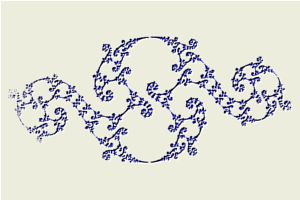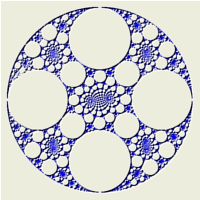
Kleinian Group Attractor Examples

Kleinian Curve |

Kleinian Disk |
The Kleinian Group Attractor examples are used to generate a Kleinian Group fractal.
Kleinian Group fractals, and the methods used to produce them, are described in the excellent book Indra's Pearls - The Vision of Felix Klein by David Mumford, Caroline Series, and David Wright. For additional details, see David Wright's Indra's Pearls site.
Change the Kleinian Group Properties
Select the equation's properties page:
General
Orbital / IFS / Strange
Attractor
Orbital Equation: Kleinian Group -
Examples
Properties
Change the Recipe property to one of the predefined recipes. Each recipe has a set of examples and you can change the Example property to view the examples for each recipe.
Change the Conjugate By property to conjugate the results with the given transformation.
Check the Transform checkbox to apply a unit circle group transformation defined by the properties Angle and Point.
Change the Transformation
You can apply a transformation to the fractal.
Execute the Home command on the View menu of the Fractal Window to reset the fractal to the default position/magnification before you adjust the transformation. Then change the transformation and Zoom In to interesting areas of the transformed image.
To apply a transformation to the fractal, select the Identity transformation's page:
General
Orbital / IFS / Strange
Attractor
Transformation 1
Identity
Set the Based On property to one of the available transformations, select the transformation's properties page (found under the transformation in the page hierarchy), and play with the properties found there.
Mobius transformations work especially well in these examples because they preserve circles; i.e., circles are mapped to circles.
To use a Mobius transformation, set the Based On property to one of the following transformations:
- Mobius Transformation
- Mobius Transformation - Elliptic
- Mobius Transformation - Hyperbolic
- Mobius Transformation - Loxodromic
- Mobius Transformation - Parabolic
- Disc Automorphism - Elliptic
- Disc Automorphism - Hyperbolic
- Disc Automorphism - Parabolic
- Disc Automorphism - General
- Half-Plane to Disk
- Circle To Circle
- Poincare Disk
- Mobius Group
Note that the default for most of these transformations is the identity transformation (which does nothing) so you will need to select the properties page found under the transformation and change the properties in the section labeled Transformation Control.